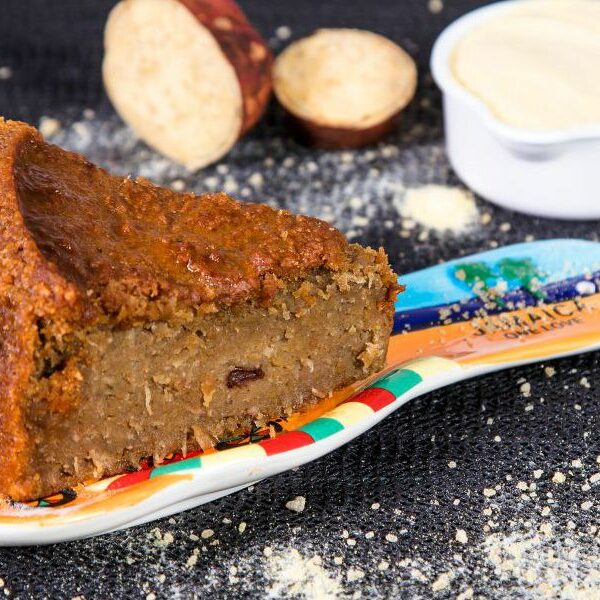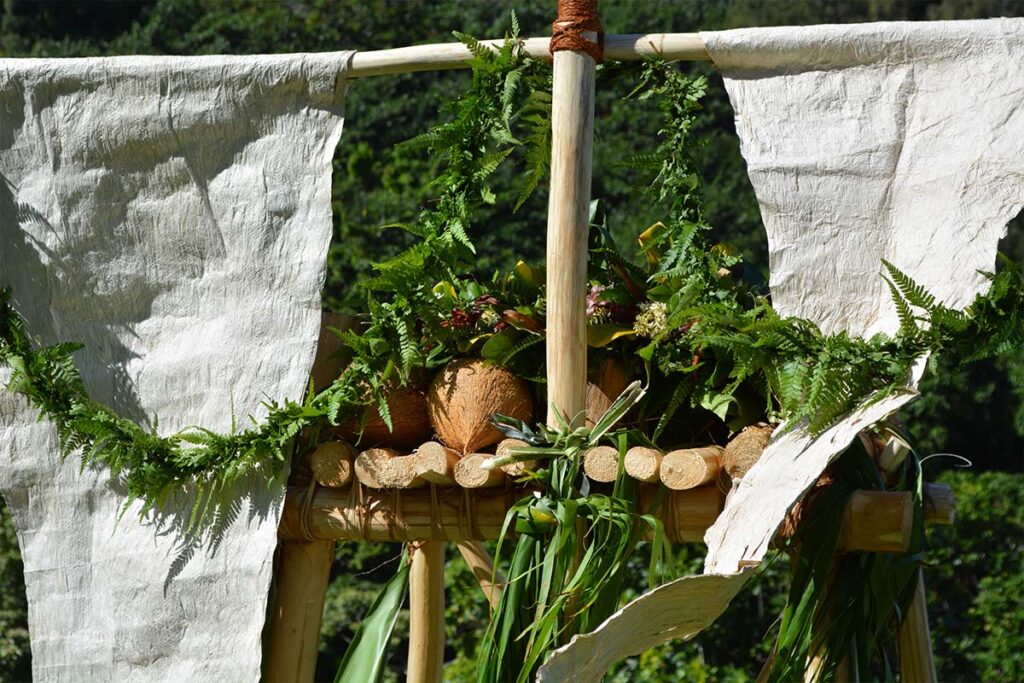
Kō‘elepālau (sweet potato pudding)
Territory: Kalihiwai on the island of Kaua’i. Halele’a and Ko’olau districts
Author: Mehana Vaughan
Recipe: Coconuts are plentiful in Hawaiʻi, brought to the islands by my ancestors, in their long voyages by canoe. Used to symbolize Hawaiʻi, the swaying palms conjure idyllic, paradise and are often gestured in hula. I chose a recipe my tutuʻs sister loved to make and I love to eat.

Mehana
This is our daughter, Mehana, of Namahana, below the gathering clouds, and Nihokū in the sea spray. She is wahine noho mauna, the fern that grows on tree bark in forest, with moss catching mist. She is the oʻopu nāniha, she teaches children to greet in the muliwai, where fresh river meets sea. Descendant of Ululani and Lono, grandaughter of Amelia, daughter of Beryl, mother of Piko, Naʻe and Ana, growing up to love and care for the land. She is dancer and teacher, listener and poet, gardener and, like her grandmother, a weaver of lei.

Recipe Name: Kō‘elepālau (sweet potato pudding), Dessert
Ingredients
- 4 large Okinawan sweet potatoes
- 12 oz. Coconut milk
- 1/2 cup Organic local honey
Directions:
Steam potatoes for approximately 1/2 hour. Use a fork to determine that it’s soft and cooked all the way through. Peel potatoes once they are cool enough to handle, using a spoon or butter knife. Mash the peeled potatoes preferably while hot. You can reheat potatoes by either quick steaming or putting in the microwave for a few minutes. Mash all lumps then gradually add the coconut milk and honey till desired consistency and sweetness, thick enough to cling to a spoon and not dry or clumpy in texture. You can also use a food processor or mixer. Serve cold.
NOTE: The best coconut milk will be homemade, from freshly grated and squeezed coconut. If you buy frozen or canned milk, allow it to sit for an hour or so in the fridge so that it separates. Scoop out and use the thick milk that settles to the top and save the liquid for use in other recipes. Again, the total amount of coconut milk used will be determined by starchiness of your potatoes. Also can be made with any kind of sweet potato, which may change amount of honey to add. Good to harvest potatoes and then let them sit in shade for a week or less. These are purple potatoes, purple or yellow are used in Hawaiʻi mainly, but any color could be. So, with that said, the “recipe” attached is merely a guide. Adjust according to texture and taste!
Explanation:
I chose a recipe my tutuʻs sister loved to make and I love to eat. It is made of sweet potatoes (uʻala in Hawaiian), so it can be made most anywhere in the world, if another kind of milk is substituted for coconut. Uʻala (sweet potato) grow in many places Iʻve visited worldwide, across the Pacific, in Peru and other parts of central and South America, and in Africa. The third ingredient in this recipe is an optional further sweetener of a bit of honey. My great aunty Marcella definitely used condensed milk and white sugar too, but those arenʻt necessary, and are imported, packaged and not so nutritious, where the rest grow from the land.
Coconuts are plentiful in Hawaiʻi, brought to the islands by my ancestors, in their long voyages by canoe. Used to symbolize Hawaiʻi, the swaying palms conjure idyllic, paradise and are often gestured in hula. Niu are the most useful of trees. They provide cordage, drums for hula, thatch, baskets, rich meat, spongy sweet sprouts, and life-giving hydrating waters. There is a Hawaiian riddle which describes niu as the “spring levitating in the air.” It takes skill to harvest niu as the Hawaiian varieties are very tall, and to know at what stage the nut is best to harvest for what form of food.
Today in Hawaiʻi, coconut trees are viewed as a hazard, as the heavy nuts falling from high above pose risk to people, buildings and vehicles. Many land owners have cut them down. Even in public spaces, maintained for instance by government, they are seen as a liability, so it is harder, particularly on more developed islands, to find and harvest them. When the trees are used for food, the nuts are harvested before they start to fall, leaves cleared away for new growth. Only unutilized and uncared for, do they become a hazard. An invasive bug, the coconut rhinocerous beetle has just been found on Kauaʻi, after killing off and threatening populations of coconut trees on other islands. Our people also love to eat fish, our main source of protein, so here are some photos of my children and I cleaning fish together, and more recently, my son with fish he has caught and cooked for our family.
